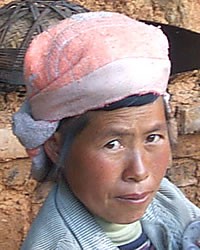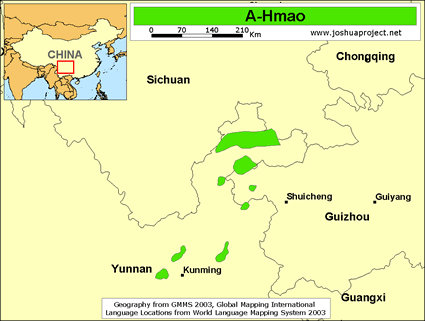The A-Hmao are one of "close to a hundred distinctive subgroups of Miao in China alone, each speaking a slightly different dialect and maintaining its own traditional customs." These people call themselves A-Hmao. The Chinese and foreigners have traditionally called them Da Hua Miao (Big Flowery Miao). The "Big Flowery Miao" (A-Hmao) speak a completely different language from the "Small Flowery Miao" (Gha-Mu) who also live in Guizhou.
The Chinese officially label A-Hmao the Diandongbei (Northeast Yunnan) dialect of Miao. It is one of the "30-40 different Miao languages in China."
For centuries, the A-Hmao lived in dire slavery to the Nosu Yi. The Nosu bullied the A-Hmao by seizing their land, taking slaves, and imposing unfair taxes on them. Nosu landowners customarily used the back of an A-Hmao slave to mount their horses.
Today most of the A-Hmaos are subsistence farmers.
Before their mass conversion to Christianity, the A-Hmao were ensnared by a complex system of evil spirits they called bidlang. The people's immorality was "so bad that they could hardly be worse. There are no decent women among the Big Flowery Miao (A-Hmao)."
When missionary Samuel Pollard first arrived in 1904, he found the A-Hmao trapped in slavery to the Nosu and overwhelmed with poverty. Together with Francis Dymond he converted them to Christianity, invented an alphabet for their language, and taught them to read and write. Although a severe famine in 1918 left many A-Hmao believers "disenchanted with Christianity," Pollard baptized 10,000 A-Hmao believers, and before the mission was expelled from China, 80,000 had turned to Christ. Some estimate that as many as 80% of the A-Hmao today are Christians.
After the departure of the missionaries, the A-Hmao church stayed steadfast to Christ, despite sinister plots during the Cultural Revolution aimed at destroying their faith. During the 1940s, the church experienced "a very serious process of retrogression and decay, which, if not soon arrested, will bring us back to our starting point again." The A-Hmao New Testament was printed in 1917; 50,000 copies were reprinted and sold out between 1983 and 1988. In 1974 many A-Hmao believers were massacred by Chinese troops when they secretly met for prayer in a cave at Xinglongchang. Instead of destroying the church, the massacre caused a doubling in the number of Christians over a short time.
The A-Hmaos need God s protection and guidance.
Pray that they courage of the A-Hmao people will drive them to spread the fragrance of Christ no matter what the cost.
Pray for the A-Hmao church to be defined by discipleship, love and joy.
Pray for revival fire to consume their churches and spread to neighboring peoples.
Pray for God s protection and goodness to permeate A-Hmao families.
Scripture Prayers for the A-Hmao in China.
Operation China, Asia Harvest, Copyrighted Used with permission.
| Profile Source: Joshua Project |











